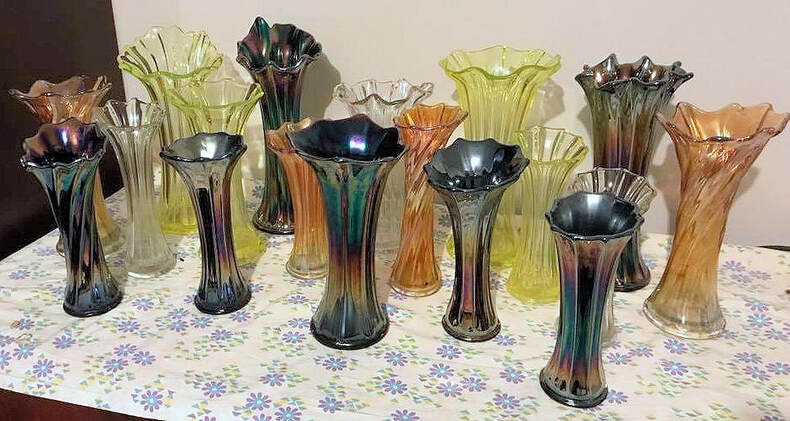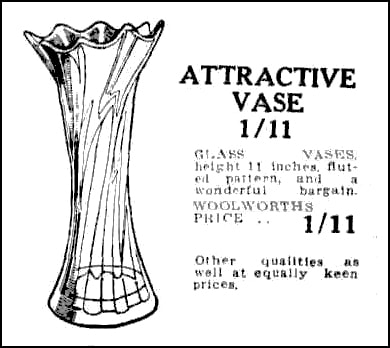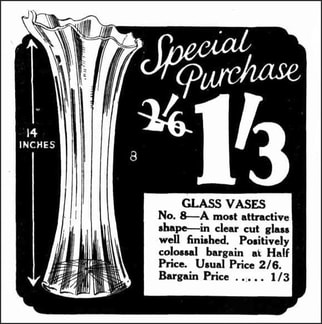Lily and Gum Tips Vases.
As portrayed in the Australian Press, 1920s - 1930s.
|
The selection of ads in this article is shown courtesy of the National Library of Australia’s Digitised Newspapers. Most of the ads seen here are from the 1920s, with a few being from the early 30s. Carnival Glass was first made in Australia c. 1919 by Crystal Glass (later Crown Crystal), and designs were registered from c. 1923. The Lily and Gum Tips vases probably date from around 1924 (or a little earlier), as the first ad we can find for them was 1924. The vases were depicted as being made in iridescent glass in Crown Crystal’s 1929 catalogue, a page from which is shown here in full-sized detail: Crown Crystal 1929 catalogue. Notably, There was no mention of iridescent ware three years later in their 1932 catalogue. |
All versions of Lily and Gum Tips vases were also made in a variety of non-iridised colours, such as vaseline (citron) and pink (rosalin).
All versions of Lily and Gum Tips vases were also made in a variety of non-iridised colours, such as vaseline (citron) and pink (rosalin).
A wonderful array of Lily and Gum Tips vases in marigold, “dark”, clear and citron (vaseline).
Photo courtesy of Giuseppe Dragone.
Photo courtesy of Giuseppe Dragone.
The different representations of the vases in these ads is fascinating – with different commercial artists chosing to depict them in their own styles. The portrayals of the vases with flowers in them are especially delightful. One of the first stores to offer Crown Crystal’s Carnival Glass vases, in Australia, was Woolworths, as the ad below shows.
A note on the currency.
All the prices shown in the ads are in Australian currency, which at the time was the Australian pound, divided into shillings and pence. So, for example, " 3/11 " was three shillings and eleven pence, or stated simply as “three and eleven”. There were 20 shillings to a pound and 12 pence to a shilling. At the time, the Australian pound was aligned with the gold standard and the British pound/shillings/pence.
|
|
In 1925, Woolworths again offered these Carnival vases, below, describing them as “lustre glassware”.
Two sizes were offered, and were discounted in price. The explanatory text in the full block ad stated that “Huge stocks of Glassware of all kinds are on hand at Woolworths, and, to make room for incoming stocks, the Directors have decided to take the drastic action of allowing for To-morrow, Monday only, 20% off all Glassware.” |
|
Moving onto 1926 - 1927, we have not - so far - found ads for iridescent Lily or Gum Tips vases. Also, noticeably, the ads that we have found from 1926 onwards, only show vases with vertical, non-twisted ribs. It was in 1926 that Crown Glass Works and Crystal Glass merged as Crown Crystal, so maybe the change was part of a rationalisation of the overall product range at that time?
|
The delightful ad on the immediate right is from 1926. It shows a trio of Lily and Gum Tips vases, in three different heights, but not iridescent. They are described as being available in clear glass and “Citron Colour” (vaseline glass) – but note that the smallest vase was not available in the vaseline/citron version. The cost of the vaseline vases was significantly higher, but they must have looked amazing filled with lilies or flowering gum. This ad on the far right is also from 1926, and once again there is no mention that the vase was iridescent. However, it’s interesting to note that it was referred to as a Lily Vase, and the higher price suggests this was indeed, the widest based Lily vase. |
This 1927 Woolworths ad (below, left) is a delight, as it also shows the Gum Tips blooms that the vase was intended for. Coveniently, a customer was able to buy "Dyed Gum-tips", being the latest "rage for home decoration."
Confusingly, although the vase is described as Gum Tips and the caption says it was “Made in Australia for Australian Gum Tips” the vase itself looks more like the Lily vase in its proportions and in the number of panels or flutes. The higher price also suggests that. Again, this emphasises the likelihood of these vases being perceived as generic rather than specific. The vase was not iridescent.
Confusingly, although the vase is described as Gum Tips and the caption says it was “Made in Australia for Australian Gum Tips” the vase itself looks more like the Lily vase in its proportions and in the number of panels or flutes. The higher price also suggests that. Again, this emphasises the likelihood of these vases being perceived as generic rather than specific. The vase was not iridescent.
|
A Woolworths ad from 1927.
|
The ad (above, on the left) was in the “Sydney Sun” in 1927. Like the Woolworth ad, it give an artistic impression how blooms might look inside the vase. Note that it was again a generic ad and that the vase was said to be “suitable for gum tips or lilies”. Also in 1927 was an ad (above on the right) from Foy’s Department Store offering generic “Lily or Gum Tip Vases”. Note that in both these ads, the vases were in clear glass and not Carnival. |
And finally, into 1928 and the early 1930s we have found several ads for (non-iridescent) Gum Tips / Lily vases.
|
1928 at Snow’s Great Bargain Basement saw a half price offer on the large Lily vases! Down from two shillings and sixpence (2/6) to one shilling and threepence (1/3). These are not in iridescent glass, but the ad is noteworthy for the way in which it portrays the height of this vase. Although the Crown Crystal catalogues notionally stated the Lily vases were 10 to 12 inches high, this ad shows that the vases at Snow’s were swung higher, up to 14 inches.
|
|
|
Further Reading
Collectors Facts: Gum Tips and Lily vases
Rundle Street Cash and Carry ad in the Adelaide Advertiser, December 1925: De Lustre glass vases.
Collectors Facts: Gum Tips and Lily vases
Rundle Street Cash and Carry ad in the Adelaide Advertiser, December 1925: De Lustre glass vases.


















